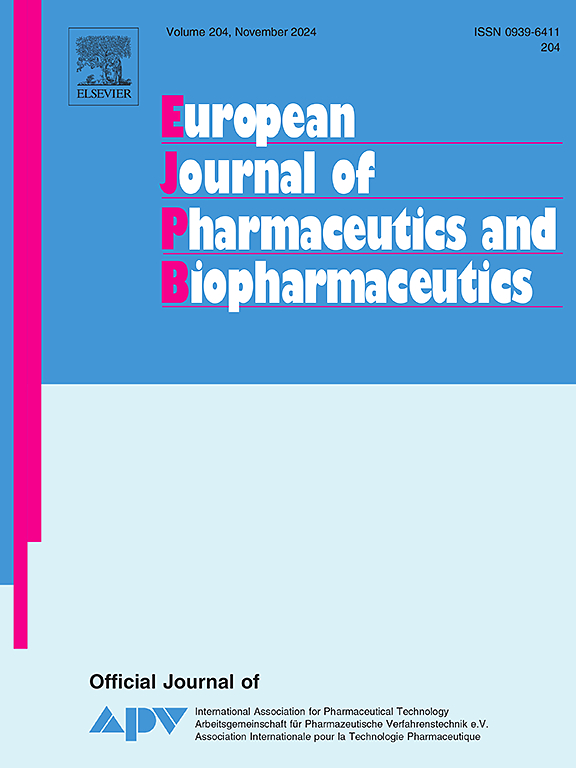Studying the effects of polymers on therapeutic deep eutectic solvents’ formation and stability: A thermal analysis-based approach to optimise polymer selection
IF 4.4
2区 医学
Q1 PHARMACOLOGY & PHARMACY
European Journal of Pharmaceutics and Biopharmaceutics
Pub Date : 2025-03-02
DOI:10.1016/j.ejpb.2025.114685
引用次数: 0
Abstract
Therapeutic deep eutectic solvents (THEDES) are the liquids produced upon mixing two solid materials, where at least one of them is an active pharmaceutical ingredient. The strong hydrogen bonding (HB) between the parent materials is the reason for such profound depression in their melting points. THEDES formation can improve drugs’ solubility and permeation characteristics. However, this can be limited by their encapsulation within drug delivery platforms e.g., polymeric matrices which might disrupt the HB network of THEDES by introducing new HB active sites into the mixture. Despite this, the effects of polymers on THEDES stability are not well-documented. In addition, the polymers’ impact on THEDES formation during end-to-end production has not been studied.
In this work, these issues were addressed by employing thermal processing of polymers and drugs. The dually active lidocaine: flurbiprofen (1:1) THEDES was utilized in addition to model polymers, namely polyethylene-co-vinyl acetate (PEVA), polyethylene oxide (PEO) and Eudragit® RL PO (EuRLPO). Firstly, probing the interaction between the polymers and the individual components of THEDES revealed that PEVA has no affinity towards both drugs while PEO can interact with flurbiprofen, and EuRLPO can interact with lidocaine. Then, to study the effect of the polymers on THEDES formation and stability, a valid in-situ method was developed to quantify THEDES in its mixture using modulated temperature differential scanning calorimetry (MTDSC). MTDSC data showed that the three polymers retarded THEDES formation in the following order PEVA < EuRLPO < PEO. This retardation was attributed to increased medium viscosity and the subsequent reduction in THEDES formation rate. Increasing the heating time led to complete THEDES formation in the case of PEVA and EuRLPO but not with PEO. This result was explained based on the polymers’ interaction with THEDES parent drugs and inputs from polymers’ viscoelastic properties. On the other hand, introducing the polymer after THEDES formation mitigated their viscosity effect but their interaction with the parent drugs remained an issue, where PEO and EuRLPO were able to destabilize the pre-formed THEDES to variable extents. Long-term storage stability study further confirmed this conclusion.
Therefore, this study will provide valuable information regarding the interaction (or lack of) of THEDES with model pharmaceutical polymers that have been thermally processed and will provide recommendations regarding the rational choice of polymers to maintain THEDES stability.

研究聚合物对治疗性深共晶溶剂形成和稳定性的影响:一种基于热分析的优化聚合物选择的方法。
治疗性深共晶溶剂(THEDES)是两种固体材料混合后产生的液体,其中至少有一种是活性药物成分。母材之间的强氢键(HB)是其熔点如此严重下降的原因。THEDES的形成可以改善药物的溶解度和渗透特性。然而,这可能受到它们在药物递送平台内的封装的限制,例如,聚合物基质可能通过将新的HB活性位点引入混合物中而破坏THEDES的HB网络。尽管如此,聚合物对THEDES稳定性的影响并没有很好的文献记载。此外,在端到端生产过程中,聚合物对THEDES形成的影响尚未得到研究。在这项工作中,这些问题是通过采用热加工聚合物和药物来解决的。除了模型聚合物,即聚乙烯-醋酸乙烯酯(PEVA),聚乙烯氧化物(PEO)和Eudragit®RLPO (EuRLPO)外,还使用了双活性利多卡因:氟比洛芬(1:1)THEDES。首先,对聚合物与THEDES单个组分的相互作用进行了探测,发现PEVA对这两种药物都没有亲和力,而PEO可以与氟比洛芬相互作用,eurolpo可以与利多卡因相互作用。然后,为了研究聚合物对THEDES形成和稳定性的影响,开发了一种有效的原位方法,使用调制温差扫描量热法(MTDSC)定量其混合物中的THEDES。MTDSC数据显示,三种聚合物对THEDES形成的阻滞程度依次为PEVA
本文章由计算机程序翻译,如有差异,请以英文原文为准。
求助全文
约1分钟内获得全文
求助全文
来源期刊
CiteScore
8.80
自引率
4.10%
发文量
211
审稿时长
36 days
期刊介绍:
The European Journal of Pharmaceutics and Biopharmaceutics provides a medium for the publication of novel, innovative and hypothesis-driven research from the areas of Pharmaceutics and Biopharmaceutics.
Topics covered include for example:
Design and development of drug delivery systems for pharmaceuticals and biopharmaceuticals (small molecules, proteins, nucleic acids)
Aspects of manufacturing process design
Biomedical aspects of drug product design
Strategies and formulations for controlled drug transport across biological barriers
Physicochemical aspects of drug product development
Novel excipients for drug product design
Drug delivery and controlled release systems for systemic and local applications
Nanomaterials for therapeutic and diagnostic purposes
Advanced therapy medicinal products
Medical devices supporting a distinct pharmacological effect.

 求助内容:
求助内容: 应助结果提醒方式:
应助结果提醒方式:


